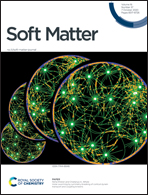Rising obstacle in a one-layer granular bed induced by continuous vibrations: two dynamical regimes governed by vibration velocity
Abstract
The rising motion of an obstacle in a vibrated granular medium is a classic problem of granular segregation, and called the Brazil nut (BN) effect. Identification of the controlling vibration parameters of the effect is a long-standing problem. The simple possibility that the BN effect can be characterized solely by vibration velocity has recently been pointed out. The issue has become controversial over the long history of research, with only a few systems providing evidence for this simple possibility. Here, we investigate the rising motion of an obstacle in a vertically positioned one-layer granular bed under continuous vibrations. We find the rising motion is composed of two distinct regimes, and the first and second regimes are both governed, in terms of vibration parameters, solely by the vibration velocity. We further demonstrate simple scaling laws that well describe the two regimes. Our results support the emergent simple possibility for the controlling parameters of the BN effect and suggest that this feature could be universal. We propose two possible mechanisms of convection and arch effect for the two distinct regimes and demonstrate that these mechanisms explain the scaling laws followed by our experimental data.



 Please wait while we load your content...
Please wait while we load your content...